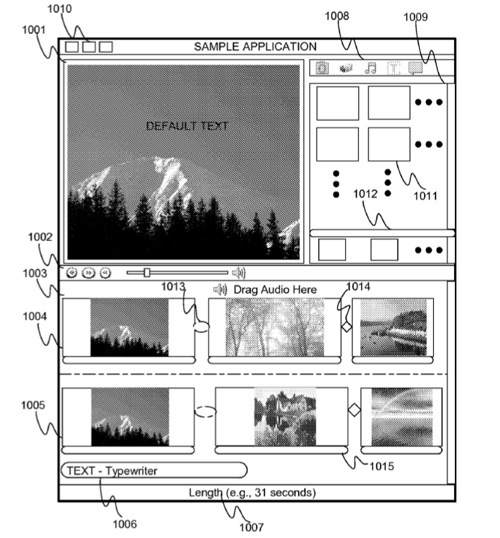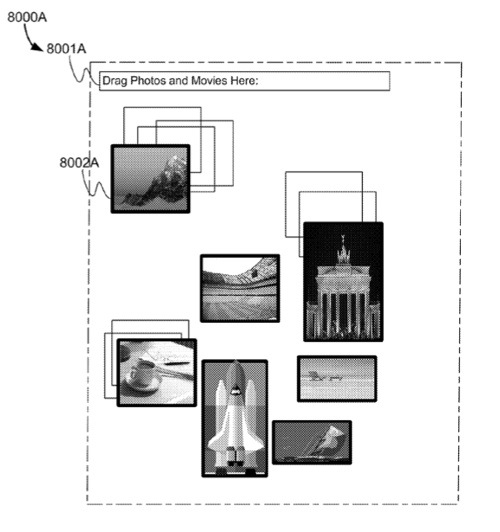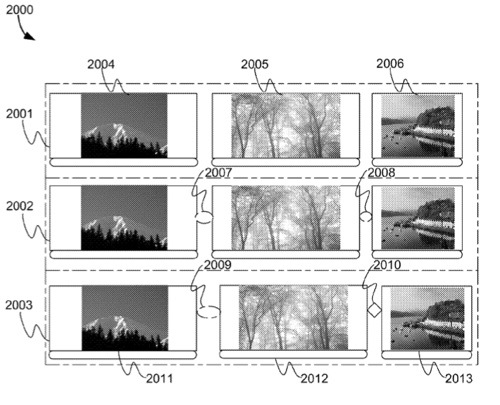Several Apple patents have appeared at the US Patent & Trademark Office that hint at either changes in Final Cut products -- or perhaps new media presentation tools.
Patent number 20100168881 is for a multimedia display based on audio and visual complexity. The present invention relates generally to the field of authoring media presentations and, in particular, to authoring media presentations using profiled audio data.
Here's Apple's background and summary of the invention: "Current media presentation applications offer features for creating slides and manually customizing the ways in which a set of slides, i.e., a slideshow, is played. Such applications also offer features for attaching themes to slideshows, where such themes may affect the appearance and general behavior of the slideshows when played. In addition, such applications further offer features such as customizing slide colors, customizing transition behavior, customizing transition delay, and manually adding clip art/image/audio/video files to one or more slides in a slideshow. These applications also permit basic sequential transition, forward or backward, from one slide to another in a slideshow containing more than one slide. A user may customize the time that one slide should be viewed prior to the application invoking a transition to another slide, which may further have a custom viewing time associated with it, as well.
"However, current media presentation applications do not dynamically profile audio data, such as a slideshow soundtrack, based on various audio parameters, including beats per minute, rhythmic strength, harmonic complexity, and/or square root of the arithmetic mean of the square of density variations (RMS) strength. In addition, current media presentation applications do not utilize the profiled audio data to select appropriate effects, transitions, or filters and assemble them in useful ways to author a media presentation. Current media presentation applications also do not set effect durations, in/out points, and transitions in-sync with audio alone or the audio of a video.
"Moreover, current media presentations applications do not author media presentations by defining a layer, where the layer comprises one or more effects, associating media content with the layer, aggregating the layer with one or more other layers, and assembling the aggregated layers. Finally, current media presentation applications do not provide automatic, as well as user-defined, authoring, rendering, exporting, and sharing media presentations/slideshows in an easily integrated platform."
Patent number 20100169389 involves an effects application based on object clustering. It relates generally to the field of media presentations and, in particular, to authoring, rendering, viewing, exporting, and sharing media effects. The inventors are Ralf Weber and Guillaume Vergnaud.
A system in accordance with the present invention may include one or more processors, memory that receives instructions from the one or more processors according to a clock operating at a frequency, one or more programs stored in the memory, with instructions to: access media content; analyze the media content according to meta data, media characteristics, or other media-related data; and, create a media content object cluster according to the meta data, the media characteristics, or the other media-related data. The inventors are Ralf Weber and Bob Van Osten.
Here's Apple's background on the invention: "Current media presentation applications offer features for creating slides and manually customizing the ways in which a set of slides, i.e., a slideshow/media presentation, is played. Such applications also offer features for attaching themes to slideshows, where such themes may affect the appearance and general behavior of the slideshows when played. In addition, such applications further offer features such as customizing slide colors, customizing transition behavior, customizing transition delay, and manually adding clip art/image/audio/video files to one or more slides in a slideshow.
"These applications also permit basic sequential transition, forward or backward, and from one slide to another in a slideshow containing more than one slide. A user may customize the time that one slide should be viewed prior to the application invoking a transition to another slide, which may further have a custom viewing time associated with it as well. However, current media presentations applications do not provide a feature for authoring media effects, comprising: accessing media content; analyzing the media content according to meta data, media characteristics, or other media-related data; and creating a media content object cluster according to the meta data, the media characteristics, or the other media-related data.
"Moreover, current media presentation applications also do not provide a feature for dynamically profiling a slideshow soundtrack based on various criteria like beats per minute (BPM), rhythmic strength (RS), harmonic complexity (HC), and/or root mean square density (RMS or RMS strength). Such criteria, when profiled intelligently, may be further used to select appropriate effects and assemble such effects in useful ways applicable to a slideshow. Further, such effects could be customized according to durations, in/out points, and transitions in-sync with audio alone or the audio of a video. Finally, current media presentation applications do not provide features for automatic, as well as user-defined, authoring, rendering, exporting, and sharing media presentations/slideshows in an easily integrated modem platform."
Patent number 20100169777 is for a light table for editing digital media. The invention relates generally to the field of media presentations and, in particular, to authoring media presentations.
A system in accordance with the present invention may include one or more processors, memory that receives instructions from the one or more processors according to a clock operating at a frequency, one or more programs stored in the memory, with instructions to: access media content, wherein the media content is associated with meta data, media characteristics, or other media-related data; couple certain of the media content to a style; and, organize the coupled certain of the media content according to the style and the meta data, media characteristics, or other media-related data. The inventors are Ralf Weber and Adrian Diaconu.
Here's Apple's background of the invention: "Current applications offer features for editing image and video files, such as editing photos by cropping, skewing, altering dimensions/colors, and adding/removing photo objects; and, for videos, by adding/removing clips/segments, attaching audio to a clip/segment, and adding/removing video objects. Furthermore, file management or media presentation/slideshow applications also provide a feature such that a group of image or video files may be viewed (e.g., as thumbnails) and organized via a file management folder and, also, media presentation/slideshow applications provide a feature for manually adding photos or videos to slides, which may then be played sequentially. In addition, some applications may provide features for manually customizing digitized photo/video albums, where the user may simply associate specific photos/videos with an album, or the application may add a group of photos/videos to an album merely based on a common storage location or as the user may specify.
"However, current applications do not provide a feature for authoring media presentations, comprising: accessing media content, wherein the media content is associated with meta data, media characteristics, or other media-related data; coupling certain of the media content to a style; and, organizing the coupled certain of the media content according to the style and the meta data, media characteristics, or other media-related data. Moreover, current applications also do not provide a feature for presenting the organized media content and, further, displaying the organized media content using a graphical user interface (e.g., a light table)."
Patent number 20100169783 involves a framework for a slideshow object. The invention relates generally to the field of media presentations and, in particular, to authoring, rendering, viewing, exporting, and sharing media presentations.
A system in accordance with the present invention may include one or more processors, memory that receives instructions from the one or more processors according to a clock operating at a frequency, one or more programs stored in the memory, with instructions to: define a layer, wherein the layer comprises one or more effects; associate media content with the layer; aggregate the layer with one or more other layers; and, assemble the aggregated layers. The inventors are Ralf Weber, Adrian Diaconu, Guillaume Vergnaud and Bob Van Osten.
Here's Apple's background on the invention: "Current media presentation applications offer features for creating slides and manually customizing the ways in which a set of slides, i.e., a slideshow/media presentation, is played. Such applications also offer features for attaching themes to slideshows, where such themes may affect the appearance and general behavior of the slideshows when played. In addition, such applications further offer features such as customizing slide colors, customizing transition behavior, customizing transition delay, and manually adding clip art/image/audio/video files to one or more slides in a slideshow.
"These applications also permit basic sequential transition, forward or backward, and from one slide to another in a slideshow containing more than one slide. A user may customize the time that one slide should be viewed prior to the application invoking a transition to another slide, which may further have a custom viewing time associated with it as well. However, current media presentations applications do not provide a feature for authoring media presentations, comprising: defining a layer, wherein the layer comprises one or more effects; associating media content with the layer; aggregating the layer with one or more other layers; and assembling the aggregated layers.
"Moreover, current media presentation applications also do not provide a feature for dynamically profiling a slideshow soundtrack based on various criteria like beats per minute (BPM), rhythmic strength (RS), harmonic complexity (HC), and/or root mean square density (RMS or RMS strength). Such criteria, when profiled intelligently, may be further used to select appropriate effects and assemble such effects in useful ways applicable to a slideshow. Further, such effects could be customized according to durations, in/out points, and transitions in-sync with audio alone or the audio of a video. Finally, current media presentation applications do not provide features for automatic, as well as user-defined, authoring, rendering, exporting, and sharing media presentations/slideshows in an easily integrated modern platform."
Patent number 20100169784 is for a slide show effects style. The invention relates generally to the field of media presentations and, in particular, to authoring media presentations using styles.
A computer-implemented method for authoring media presentations is provided. The method includes steps for defining a style. The style comprises one or more style properties. The style is applied to a layer. The layer comprises one or more effects. The style may also be applied to a document, effect container, effect, or slide. A media presentation is automatically generated using the applied style and the layer. A media presentation is also automatically generated using the applied style and the document and at least one of the layer, the effect container, the effect, and the slide. The inventors are Ralf Weber, Adrian Diaconu, Guillaume Vergnaud and Bob Van Osten.
Here's Apple's background on the invention: "Current media presentation applications offer features for creating slides and manually customizing the ways in which a set of slides, i.e., a slideshow, is played. Such applications also offer features for attaching themes to slideshows, where such themes may affect the appearance and general behavior of the slideshows when played. In addition, such applications further offer features such as customizing slide colors, customizing transition behavior, customizing transition delay, and manually adding clip art/image/audio/video files to one or more slides in a slideshow. These applications also permit basic sequential transition, forward or backward, from one slide to another in a slideshow containing more than one slide. A user may customize the time that one slide should be viewed prior to the application invoking a transition to another slide, which may further have a custom viewing time associated with it, as well.
"However, current media presentation applications do not define a style, the style comprising one or more style properties, apply the style to a layer, the layer comprising one or more effects, and automatically generate a media presentation using the applied style and the layer.
"Furthermore, current media presentation applications do not dynamically profile audio data, such as a slideshow soundtrack, based on various audio parameters, including beats per minute, rhythmic strength, harmonic complexity, and/or square root of the arithmetic mean of the square of density variations (RMS) strength. In addition, current media presentation applications do not utilize the profiled audio data to select appropriate effects, transitions, or filters and assemble them in useful ways to author a media presentation. Current media presentation applications also do not set effect durations, in/out points, and transitions in-sync with audio alone or the audio of a video.
"Moreover, current media presentations applications do not author media presentations by defining a layer, where the layer comprises one or more effects, associating media content with the layer, aggregating the layer with one or more other layers, and assembling the aggregated layers. Finally, current media presentation applications do not provide automatic, as well as user-defined, authoring, rendering, exporting, and sharing media presentations/slideshows in an easily integrated platform."
-- Dennis Sellers















